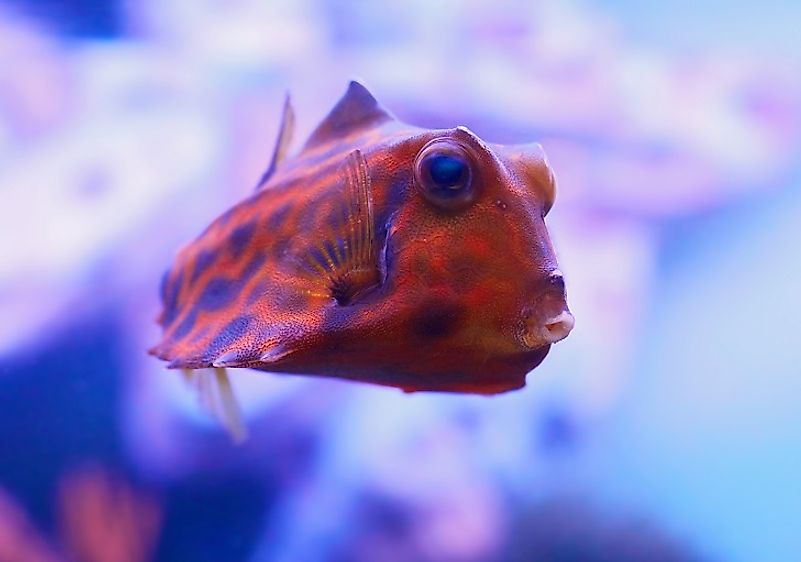Native Fish Species Of India

India is home to a wide range of diverse and unique species of fish. They include both freshwater fishes, brackish water fishes, and marine fishes in the areas of Bengal, Arabian Sea, and the Indian Ocean. Freshwater fishes consist of about 940 species which constitutes about 38% of the total Indian fish fauna. Of these, about 500 species are endemic to India. Some of the species are introduced into the waters of India from other places. Some also occur in other locations and countries as others are migratory fishes.
Round Jaw Bonefish (Albula vulpes)
The distinctive feature about this fish is in the inferior mouth and the pointed nose that protrudes a third of its length beyond the mandible. They have slender and round bodies and have a convex dorsal. They appear blue-greenish above with silver scales below. They have no spines. Their teeth are granular and form specialized dental plates that cover the tongue and the upper jaw with similar grindings on the throat. They feed on benthic and epibenthic prey found in waters of a depth of less than 30 centimeters. Their prey consists of crustaceans, worms, and mollusks. They are predominantly coastal species that are common in mangrove areas, river mouths, intertidal flats, and deeper waters. They can tolerate poorly oxygenated water by inhaling air into lung-like air bladder. They swim in groups of up to 100 individuals. They move to shallow waters during the rising tides and into deeper water during a falling tide. They also inhabit a location for several days and relocate to another place. In hot temperatures, they restrict themselves to deep water and resurface when the temperatures are cool. Spawning occurs all year round. They reach sexual maturity after two years. They spawn in deep waters where currents can quickly disperse the eggs and larvae to other areas. The transformation from larvae to juvenile occurs in three stages. The first stage they lack the dorsal anal and pectoral fins and look like ribbons. In stage two the anal and dorsal fins appear and snout projects its length. Stage three scales, lateral lines, and color develop. The International Union for the Conservation of Nature (IUCN) does not classify them as vulnerable or endangered as they occur in large populations.
Mirror Dory (Zenopsis nebulosa)
They have high dorsal fins that contain nine spiny rays. The second dorsal fin contains 27 soft rays. There are large spines on each side of the body at the base of dorsal and anal fins. The body is silver with a dark patch in the middle of each flank and lacks scales. They grow to up to 70 centimeters in length and 3 kilograms in weight. They can live to up to 12 years. They live close to the seabed at depths of 50 to 600 meters under the water's surface in coastal and continental waters. They are solitary and sometimes can be in groups with the gemfish. They eat other fish like jack mackerel, crustaceans, and mollusks. They attain sexual maturity at five years and spawn over the winter period.
Hardyhead Silverside (Atherinomorus lacunosus)
They have low and wide lateral jutting out of their premaxilla and the dorsal spines. The tip of its upper jaw extends the anterior margin of the pupil. They move in large schools of about 100 along the sandy shorelines and reef margins. They are mainly nocturnal, and they feed at night when the school is dispersed. They also move slowly and are not good as bait fish. They prey on crustaceans.
Humpback Turretfish (Tetrosomus gibbosus)
The Humpback Turretfish grows to 30 centimeters in length, and a poisonous mucus covers their bodies which is released when the fish is stressed or in danger. They are usually found in offshore deep water over the coastal slopes and sheltered muddy and sandy substrates. Occasionally they inhabit shallow algae and seagrass beds with soil deposits and partly destroyed coral reefs. Their depth ranges to up to 110 meters below the surface. They feed mostly on worms, crustaceans, mollusks, sponges and macroalgae. Species also occur in East Africa, Indonesia, North Japan, and Australia. IUCN lists it as least concern due to their large population and wide ranges. General threats include commercial harvests and habitat degradation.
Conservation of the Fish of India
Also among the endemic fish of India are the flat needlefish, the garo spineless eel, the Kashmir triplophysa, the peninsular hill trout, and the Canara pearl sport. Threats to these fishes are plenty, and they include urbanization, deforestation, habitat loss, pollution, over-harvesting, and culture of exotics and invasive species. India is in fact widely recognized as a fishing center, and this increases the risk of threats to its aquatic fauna. It is important to create awareness among those who fish and fishermen about the protection of fish species in the Indian waters.
Native Fish Species Of India
| Native Fish of India | Scientific Name |
|---|---|
| Roundjaw Bonefish | Albula vulpes |
| Mirror Dory | Zenopsis nebulosa |
| Hardyhead Silverside | Atherinomorus lacunosus |
| Humpback Turretfish | Tetrosomus gibbosus |
| Flat Needlefish | Ablennes hians |
| Garo Spineless Eel | Garo khajuriai |
| Kashmir Triplophysa Loach | Triplophysa marmorata |
| Peninsular Hilltrout | Lepidopygopsis typus |
| Indian Sillago | Sillago indica |
| Canara Pearlspot | Etroplus canarensis |











